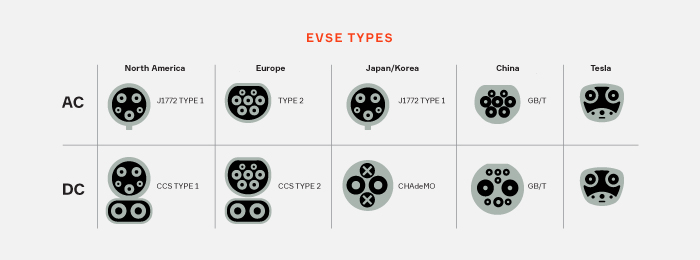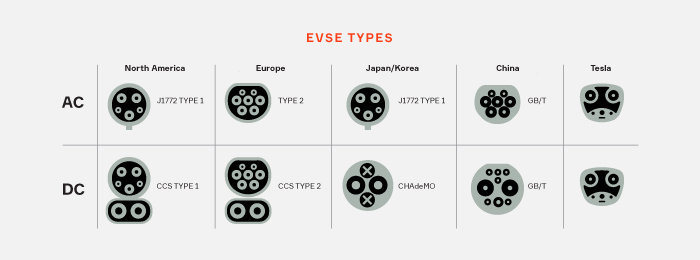What Are EV Charger Types, Levels and Modes?
EVs are gaining popularity all over the world, and EV charging is developing differently for different regions and use cases. This makes for a high degree of complexity — and a lot of part numbers — for global OEMs. But there are three generally accepted descriptors for electric vehicle supply equipment (EVSE), which includes EV chargers: mode, level and type.
Mode: The mode reflects how the EVSE connects to the electrical grid.
- Mode 1 plugs into a household AC socket, but it generally is not permitted in most regions, because Mode 1 lacks special safety electronics.
- Mode 2 also plugs into a standard household AC outlet and includes those safety features in its in-cable control box (ICCB).
- Mode 3 plugs into a wall box or charging station for an AC charge. It does not include an ICCB. Consumers are often required to bring their own Mode 3 cable to use public AC charging stations in Europe.
- Mode 4 is reserved for high-speed DC charging at charging stations.
Level: The level indicates how much electric power is delivered to the vehicle. The Society of Automotive Engineers specifies the following levels in the J1772 standard:
- Level 1 is limited to 120V and 1.8 kW and delivers basic charging.
- Level 2 is defined as 208V to 240V and up to 80A, with a maximum output of 19.2 kW. As OEMs increase battery sizes, they are also increasing the power level within this band. Typical BEVs today can take 11 kW of AC power via their onboard chargers. Homes with three-phase power installed can reach 11 kW with 16A of current, while a single-phase power source would need to supply about 48A.
- DC Level 1 and 2 provide fast charging and are only available at commercial stations. DC Level 2, commonly referred to as simply “Level 3,” can provide up to 1,000 VDC and is projected to reach 500A in the future, with a power output of more than 350 kW. This rate can charge about 80 percent of a typical EV battery in as little as 20 minutes.
Type: Type refers to the vehicle interface. Unfortunately, standards organizations have not aligned behind a global standard. Consequently, there are three unique interfaces for AC charging globally:
- North America and Korea use J1772 Type 1 for AC and CCS1 for DC.
- Europe uses IEC Type 2 for AC and CCS2 for DC.
- Japan uses J1772 Type 1 for AC but CHAdeMO for DC.
- China uses the GB/T interface for AC and a unique DC interface.
- In addition, the emerging ChaoJi standard may be adopted in both China and Japan

